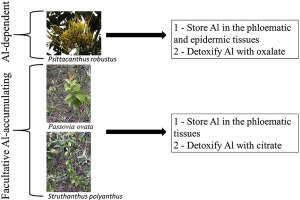当前位置:
X-MOL 学术
›
Phytochemistry
›
论文详情
Our official English website, www.x-mol.net, welcomes your feedback! (Note: you will need to create a separate account there.)
Aluminium detoxification in facultative ( Passovia ovata (Pohl ex DC.) Kuijt and Struthanthus polyanthus Mart. - Loranthaceae) and dependent ( Psittacanthus robustus (Mart.) Marloth - Loranthaceae) Al-accumulating mistletoe species from the Brazilian savanna
Phytochemistry ( IF 3.8 ) Pub Date : 2018-09-01 , DOI: 10.1016/j.phytochem.2018.05.020 Marcelo Claro de Souza , Marina Corrêa Scalon , Charlotte Poschenrieder , Roser Tolrà , Tiago Venâncio , Simone Pádua Teixeira , Fernando Batista Da Costa
Phytochemistry ( IF 3.8 ) Pub Date : 2018-09-01 , DOI: 10.1016/j.phytochem.2018.05.020 Marcelo Claro de Souza , Marina Corrêa Scalon , Charlotte Poschenrieder , Roser Tolrà , Tiago Venâncio , Simone Pádua Teixeira , Fernando Batista Da Costa

|
Mechanisms to detoxify aluminium (Al) is a hot topic for cultivated plants. However, little information is known about the mechanisms used by native plants to deal with Al-toxicity. In Cerrado, some generalist mistletoe species, such as Passovia ovata (Pohl ex DC.) Kuijt and Struthanthus polyanthus Mart. can parasitize Al-accumulating and Al-excluding plant species without any clear symptoms of toxicity and mineral deficiency, while Psittacanthus robustus (Mart.) Marloth, a more specialist mistletoe, seems to be an Al-dependent species, parasitizing only Al-accumulating hosts. Here we (i) characterized the forms and compartmentalization of Al in leaves of P. robustus; (ii) compared Ca and Al leaf concentration, and leaf concentration of organic acids and polyphenols between facultative Al-accumulating (P. ovata and S. polyanthus) and Al-dependent (P. robustus) mistletoe species infecting Miconia albicans (Sw.) Steud. (Al-accumulating species). P. robustus chelated Al3+ with oxalate and stored it in the phloematic and epidermic leaf tissues. Leaf Ca and Al concentration did not differ among species. Leaf oxalate concentration was higher in the Al-dependent species. Concentrations of citrate and phenolic compounds were higher in the leaves of the facultative Al-accumulating species. These results show that facultative Al-accumulating and Al-dependent species use different mechanisms to detoxify Al. Moreover, this is the first report on a mistletoes species (P. robustus) with a potential calcifuge behaviour in Cerrado.
中文翻译:

兼性(Passovia ovata (Pohl ex DC.) Kuijt 和 Struthanthus polyanthus Mart. - Loranthaceae)和依赖( Psittacanthusrobustus (Mart.) Marloth - Loranthaceae)来自巴西稀树草原的积铝槲寄生物种中的铝解毒
铝 (Al) 解毒机制是栽培植物的热门话题。然而,关于本地植物用于处理铝毒性的机制的信息知之甚少。在塞拉多,一些通才槲寄生物种,例如 Passovia ovata (Pohl ex DC.) Kuijt 和 Struthanthus polyanthus Mart。可以寄生于积铝和排除铝的植物物种而没有任何明显的毒性和矿物质缺乏症状,而更专业的槲寄生 Psittacanthusrobustus (Mart.) Marloth 似乎是一种依赖铝的物种,只寄生于积铝的宿主. 在这里,我们 (i) 表征了 P.robustus 叶子中 Al 的形式和区室化;(ii) 比较了兼性积铝(P. ovata 和 S. polyanthus) 和铝依赖 (P.robustus) 槲寄生物种感染 Miconia albicans (Sw.) Steud。(铝积累物种)。P.robustus 用草酸盐螯合 Al3+ 并将其储存在韧皮部和表皮叶组织中。叶 Ca 和 Al 浓度在物种之间没有差异。在依赖铝的物种中,叶草酸盐浓度较高。兼性积铝物种的叶子中柠檬酸盐和酚类化合物的浓度较高。这些结果表明兼性积累铝和依赖铝的物种使用不同的机制来解毒铝。此外,这是关于在塞拉多具有潜在钙化行为的槲寄生物种(P.robustus)的第一份报告。robustus 用草酸盐螯合 Al3+ 并将其储存在韧皮部和表皮叶组织中。叶 Ca 和 Al 浓度在物种之间没有差异。在依赖铝的物种中,叶草酸盐浓度较高。兼性积铝物种的叶子中柠檬酸盐和酚类化合物的浓度较高。这些结果表明兼性积累铝和依赖铝的物种使用不同的机制来解毒铝。此外,这是关于在塞拉多具有潜在钙化行为的槲寄生物种(P.robustus)的第一份报告。robustus 用草酸盐螯合 Al3+ 并将其储存在韧皮部和表皮叶组织中。叶 Ca 和 Al 浓度在物种之间没有差异。在依赖铝的物种中,叶草酸盐浓度较高。兼性积铝物种的叶子中柠檬酸盐和酚类化合物的浓度较高。这些结果表明兼性积累铝和依赖铝的物种使用不同的机制来解毒铝。此外,这是关于在塞拉多具有潜在钙化行为的槲寄生物种(P.robustus)的第一份报告。兼性积铝物种的叶子中柠檬酸盐和酚类化合物的浓度较高。这些结果表明兼性积累铝和依赖铝的物种使用不同的机制来解毒铝。此外,这是关于在塞拉多具有潜在钙化行为的槲寄生物种(P.robustus)的第一份报告。兼性积铝物种的叶子中柠檬酸盐和酚类化合物的浓度较高。这些结果表明兼性积累铝和依赖铝的物种使用不同的机制来解毒铝。此外,这是关于在塞拉多具有潜在钙化行为的槲寄生物种(P.robustus)的第一份报告。
更新日期:2018-09-01
中文翻译:

兼性(Passovia ovata (Pohl ex DC.) Kuijt 和 Struthanthus polyanthus Mart. - Loranthaceae)和依赖( Psittacanthusrobustus (Mart.) Marloth - Loranthaceae)来自巴西稀树草原的积铝槲寄生物种中的铝解毒
铝 (Al) 解毒机制是栽培植物的热门话题。然而,关于本地植物用于处理铝毒性的机制的信息知之甚少。在塞拉多,一些通才槲寄生物种,例如 Passovia ovata (Pohl ex DC.) Kuijt 和 Struthanthus polyanthus Mart。可以寄生于积铝和排除铝的植物物种而没有任何明显的毒性和矿物质缺乏症状,而更专业的槲寄生 Psittacanthusrobustus (Mart.) Marloth 似乎是一种依赖铝的物种,只寄生于积铝的宿主. 在这里,我们 (i) 表征了 P.robustus 叶子中 Al 的形式和区室化;(ii) 比较了兼性积铝(P. ovata 和 S. polyanthus) 和铝依赖 (P.robustus) 槲寄生物种感染 Miconia albicans (Sw.) Steud。(铝积累物种)。P.robustus 用草酸盐螯合 Al3+ 并将其储存在韧皮部和表皮叶组织中。叶 Ca 和 Al 浓度在物种之间没有差异。在依赖铝的物种中,叶草酸盐浓度较高。兼性积铝物种的叶子中柠檬酸盐和酚类化合物的浓度较高。这些结果表明兼性积累铝和依赖铝的物种使用不同的机制来解毒铝。此外,这是关于在塞拉多具有潜在钙化行为的槲寄生物种(P.robustus)的第一份报告。robustus 用草酸盐螯合 Al3+ 并将其储存在韧皮部和表皮叶组织中。叶 Ca 和 Al 浓度在物种之间没有差异。在依赖铝的物种中,叶草酸盐浓度较高。兼性积铝物种的叶子中柠檬酸盐和酚类化合物的浓度较高。这些结果表明兼性积累铝和依赖铝的物种使用不同的机制来解毒铝。此外,这是关于在塞拉多具有潜在钙化行为的槲寄生物种(P.robustus)的第一份报告。robustus 用草酸盐螯合 Al3+ 并将其储存在韧皮部和表皮叶组织中。叶 Ca 和 Al 浓度在物种之间没有差异。在依赖铝的物种中,叶草酸盐浓度较高。兼性积铝物种的叶子中柠檬酸盐和酚类化合物的浓度较高。这些结果表明兼性积累铝和依赖铝的物种使用不同的机制来解毒铝。此外,这是关于在塞拉多具有潜在钙化行为的槲寄生物种(P.robustus)的第一份报告。兼性积铝物种的叶子中柠檬酸盐和酚类化合物的浓度较高。这些结果表明兼性积累铝和依赖铝的物种使用不同的机制来解毒铝。此外,这是关于在塞拉多具有潜在钙化行为的槲寄生物种(P.robustus)的第一份报告。兼性积铝物种的叶子中柠檬酸盐和酚类化合物的浓度较高。这些结果表明兼性积累铝和依赖铝的物种使用不同的机制来解毒铝。此外,这是关于在塞拉多具有潜在钙化行为的槲寄生物种(P.robustus)的第一份报告。


























 京公网安备 11010802027423号
京公网安备 11010802027423号